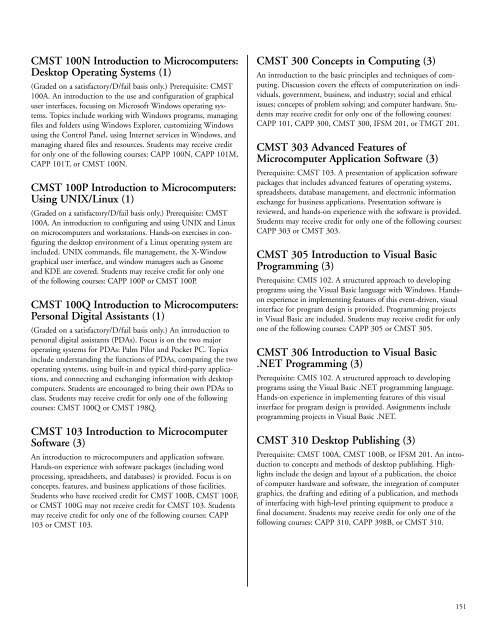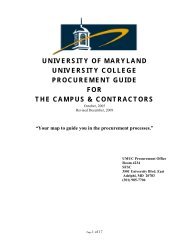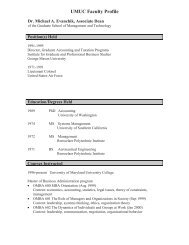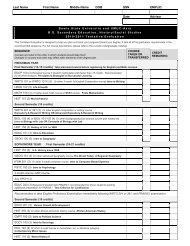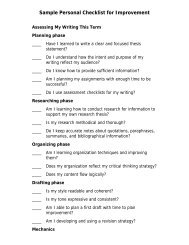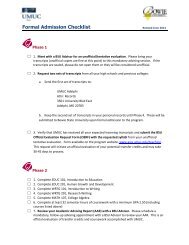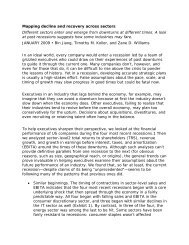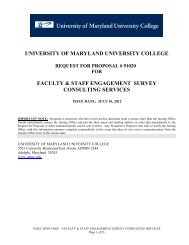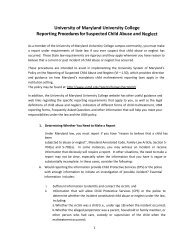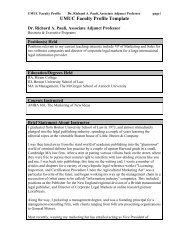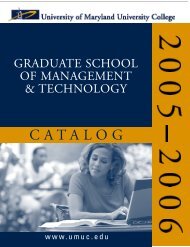1a. IntroSUS 2003 - University of Maryland University College
1a. IntroSUS 2003 - University of Maryland University College
1a. IntroSUS 2003 - University of Maryland University College
- No tags were found...
You also want an ePaper? Increase the reach of your titles
YUMPU automatically turns print PDFs into web optimized ePapers that Google loves.
CMST 100N Introduction to Microcomputers:Desktop Operating Systems (1)(Graded on a satisfactory/D/fail basis only.) Prerequisite: CMST100A. An introduction to the use and configuration <strong>of</strong> graphicaluser interfaces, focusing on Micros<strong>of</strong>t Windows operating systems.Topics include working with Windows programs, managingfiles and folders using Windows Explorer, customizing Windowsusing the Control Panel, using Internet services in Windows, andmanaging shared files and resources. Students may receive creditfor only one <strong>of</strong> the following courses: CAPP 100N, CAPP 101M,CAPP 101T, or CMST 100N.CMST 100P Introduction to Microcomputers:Using UNIX/Linux (1)(Graded on a satisfactory/D/fail basis only.) Prerequisite: CMST100A. An introduction to configuring and using UNIX and Linuxon microcomputers and workstations. Hands-on exercises in configuringthe desktop environment <strong>of</strong> a Linux operating system areincluded. UNIX commands, file management, the X-Windowgraphical user interface, and window managers such as Gnomeand KDE are covered. Students may receive credit for only one<strong>of</strong> the following courses: CAPP 100P or CMST 100P.CMST 100Q Introduction to Microcomputers:Personal Digital Assistants (1)(Graded on a satisfactory/D/fail basis only.) An introduction topersonal digital assistants (PDAs). Focus is on the two majoroperating systems for PDAs: Palm Pilot and Pocket PC. Topicsinclude understanding the functions <strong>of</strong> PDAs, comparing the twooperating systems, using built-in and typical third-party applications,and connecting and exchanging information with desktopcomputers. Students are encouraged to bring their own PDAs toclass. Students may receive credit for only one <strong>of</strong> the followingcourses: CMST 100Q or CMST 198Q.CMST 103 Introduction to MicrocomputerS<strong>of</strong>tware (3)An introduction to microcomputers and application s<strong>of</strong>tware.Hands-on experience with s<strong>of</strong>tware packages (including wordprocessing, spreadsheets, and databases) is provided. Focus is onconcepts, features, and business applications <strong>of</strong> those facilities.Students who have received credit for CMST 100B, CMST 100F,or CMST 100G may not receive credit for CMST 103. Studentsmay receive credit for only one <strong>of</strong> the following courses: CAPP103 or CMST 103.CMST 300 Concepts in Computing (3)An introduction to the basic principles and techniques <strong>of</strong> computing.Discussion covers the effects <strong>of</strong> computerization on individuals,government, business, and industry; social and ethicalissues; concepts <strong>of</strong> problem solving; and computer hardware. Studentsmay receive credit for only one <strong>of</strong> the following courses:CAPP 101, CAPP 300, CMST 300, IFSM 201, or TMGT 201.CMST 303 Advanced Features <strong>of</strong>Microcomputer Application S<strong>of</strong>tware (3)Prerequisite: CMST 103. A presentation <strong>of</strong> application s<strong>of</strong>twarepackages that includes advanced features <strong>of</strong> operating systems,spreadsheets, database management, and electronic informationexchange for business applications. Presentation s<strong>of</strong>tware isreviewed, and hands-on experience with the s<strong>of</strong>tware is provided.Students may receive credit for only one <strong>of</strong> the following courses:CAPP 303 or CMST 303.CMST 305 Introduction to Visual BasicProgramming (3)Prerequisite: CMIS 102. A structured approach to developingprograms using the Visual Basic language with Windows. Handsonexperience in implementing features <strong>of</strong> this event-driven, visualinterface for program design is provided. Programming projectsin Visual Basic are included. Students may receive credit for onlyone <strong>of</strong> the following courses: CAPP 305 or CMST 305.CMST 306 Introduction to Visual Basic.NET Programming (3)Prerequisite: CMIS 102. A structured approach to developingprograms using the Visual Basic .NET programming language.Hands-on experience in implementing features <strong>of</strong> this visualinterface for program design is provided. Assignments includeprogramming projects in Visual Basic .NET.CMST 310 Desktop Publishing (3)Prerequisite: CMST 100A, CMST 100B, or IFSM 201. An introductionto concepts and methods <strong>of</strong> desktop publishing. Highlightsinclude the design and layout <strong>of</strong> a publication, the choice<strong>of</strong> computer hardware and s<strong>of</strong>tware, the integration <strong>of</strong> computergraphics, the drafting and editing <strong>of</strong> a publication, and methods<strong>of</strong> interfacing with high-level printing equipment to produce afinal document. Students may receive credit for only one <strong>of</strong> thefollowing courses: CAPP 310, CAPP 398B, or CMST 310.151


